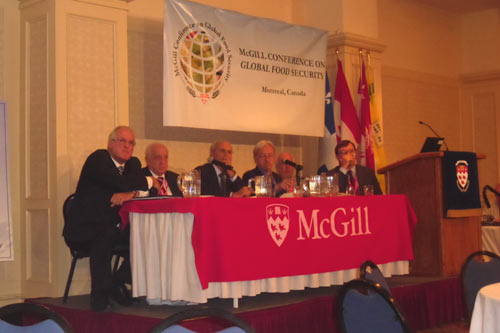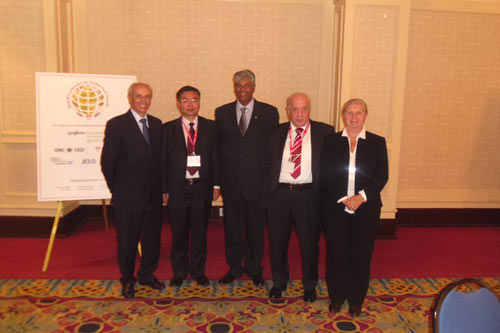INTERNATIONAL CONFERENCE “GLOBAL FOOD SECURITY AND WATER”
Montreal, Canada, 11-15 October 2012
Fifth International Conference on global food security was organized by McGill University in cooperation with the International Commission on Irrigation and Drainage, FAO, the World Bank and the Research Centre for International Development (Canada) under the auspices of the Ministry of Agriculture of Canada.

The world community, international organizations and research centers working in the area of overcoming hunger and poverty, are extremely concerned about food prices imbalance and fluctuations that were observed since 2000. Sharp and quite unreasonable changes and growth of the world market prices have led to failure of the planned UN Millennium Development Goals to reduce the number of hungry people by half.
Meanwhile, the problem of hunger is not just a problem of nourishment, but is a problem of life and social well being. In a world 1.5 billion farmers, 40% of the population is actively connected to agriculture, and 75% of the poor people are living in rural areas. Comparing to 2000, when the number of hungry people was 850 million according to FAO, and then was reduced to 10-15 million in 2005, this number has grown to 920 million in 2008 and jumped to 1020 million in 2009 and now has fallen to 2008 level. Instead of reducing the undernourished population, the world had got the increasing, and this is during the time when the production of food in the world has increased. If to assess food production in the world as a whole then we recognize that in average everyday 4600 calories per person are produced. But various kinds of food losses and unreasonable use of food like for bio-ethanol production reduce that amount to 2,000 calories per person at the average. At the same time, there are large areas where one person has much less - up to 1,200 calories a day. In Asia and the Pacific Region, the number of hungry people amounted 578 million, in Africa (Sub-Saharan) - 239, in Latin America - 53 million people (Mueller, FAO, 2011).
Along with this, China - the most populous country in the world - not only overcame this problem, but also produced an excess of commodity grain. Dr. Gao Zhanyi, President of the International Commission on Irrigation and Drainage, in his report “Policies and Practices in China for creating food security” showed that though China has a 6% of the world water resources and 9% of the world land resources, this state has fed with 21% of the world population. 584 million tons of grain were produced in 2010 under the demand of 566 million tons. This example is worthy to be copied, because it shows that the world can feed itself, if the state strongly follows to the program of food safety. This program (Document ¹ 1 of the Central Government, 2011) includes an increase of irrigated area to 66 million hectares in 2020 in comparing to 60 million hectares at present, and support for small and medium-sized land owners, as well as an increase of capital investment for water conservation and drainage of irrigated land. At the same time it is supposed to improve cultivation technology, to adopt new varieties of crops, to control soil erosion, to use new fertilizers and the integrated agricultural innovations. One of the tasks is to strengthen the Water User Associations and turn them into cooperative multi-sectoral associations of farmers.
The private company "Ecopia" from Ethiopia demonstrated how to improve the technological line from producer to end user as case study on mango and other horticultural products. This company organized monitoring of all technological processes, their computerized accounting, recording of potential suppliers of fertilizers, equipment and consumer demand within its farm of 70 hectares and a dozen neighboring farms in 2005. The agricultural complex has increased farmers' income by 2.5 times on the basis of abovementioned. Currently, the company serves 11000 farmers, who is producing very different products, covering their accounting and comprehensive information on the full range of their needs on the basis of sms-technology.
Great attention was paid to the African countries and various organizations together with governments for overcoming hunger and poverty. Kenya, Uganda, Tanzania, Ethiopia are intensively establishing the consulting firms and using them to implement the proposed technologies for crop growing. In all countries, the public service "ACC" (Agricultural consulting service), which is entrusted this activity, was organized. Farmers have the greatest benefit from the earlier preparation of land for crop growing and timely implementation of processing according to advice of experts, from selection of high-yielding and drought-resistant crop varieties, irrigation, and using compost. At the same time it is noted that the success of innovations in agricultural production is connected with implementation of not individual operations, but technological integrated complexes of knowledge, which give possibility to complement the practice with modern methods and techniques, and the use of machines, and, where it is possible on scale and financial capacity, of mechanisms on the basis of study and analysis of current practices. This requires the support of the state, involvement of public universities and research centers to the advisory work, as well as the corresponding loans. In Kenya the inter-sectoral agricultural association that organizes the interaction between private, state and local agencies for coordination all the work is created. This organization, aiming to disseminate knowledge and to implement innovation, advertises consolidation of farmers into the informal groups that share their and at the same time help to spread their neighbors' experience.
Along with decision to increase food production at the micro- and meso- level, macroeconomic factors are essential. Interestingly, that FAO and the World Bank showed themselves completely helpless in its inability to explain and even to predict the possible fluctuations in world food prices. The world prices trend is more or less understandable, but their fluctuations are unexpected and often paradoxical. Apparently there are market factors that are pulling the strings of unknown conjuncture forces and the stock exchange operations.
According to Indian experts on macroeconomic planning to solve the issue on stabilizing the world food prices can serve the created world stabilization funds of food reserves. Thus, in India such a fund of $ 1 per person (U.S. $ 1.2 billion) has reduced the amount of hungry people by 21%.
The USAID report about United States and Canada was as an original alarm for developed countries. In 2011 U.S.A. spent 103 billion dollars to help those who experiences (approximately, every 4th resident) deficit of food. 14.9% of population is undernourished, including malnourished - nearly 6.8 million people are starving or 5.8%!!! At the same time the number of undernourished people has increased in comparison with 2000, when these figures were 10% and 3%. In Canada, the situation is much better, but in this richest country-exporter the nourishment deficit is observed for 6% of people and the very needy people in food amounted 2.5%.
The report of the Central Asian specialists (V.A. Dukhovny, Sh.Sh. Mukhamedjanov, G.V. Stulina) was devoted to food security in Central Asia. It is noted that the actual food supply is reached by Kazakhstan, Uzbekistan and Turkmenistan. Somewhat more complicated situation is in Tajikistan and especially in Kyrgyzstan, where the social component does not allow to provide sufficient nutrition for almost 40% of population that receives less than 2200 calories a day.

Approaches developed in Uzbekistan to improve land productivity, implemented on the area of almost half a million hectares, and which are successfully applied in Kyrgyzstan and Tajikistan, are presented. At the same time it is pointed out that the increasing of hydropower hydroegoism threatens the stability and predictability of summer releases from the reservoirs for energy production, which release water in their interests and that releases' fluctuations result in great water deficit for irrigated agriculture.
This factor is reflected in the final statement of Prof. Chandra Madramootoo, Conference Chairman and Vice-Chancellor of the McGill University, as well as in the decision of Conference.

The decision also noted the need for:
- increasing capital investment to agriculture, and especially to its infrastructure;
- organizing the world's food regulatory policy and global food market;
- development of rural social potential;
- development of farms credit and their associations with particular attention to small and medium-sized farms;
- creation of food security nets.
Prof. Dukhovny V.A.,
Director of SIC ICWC
|